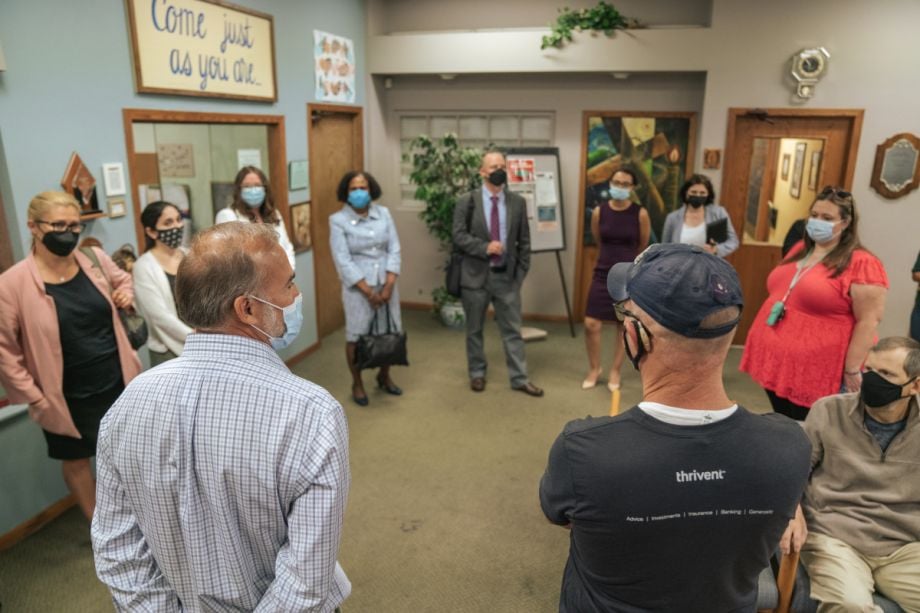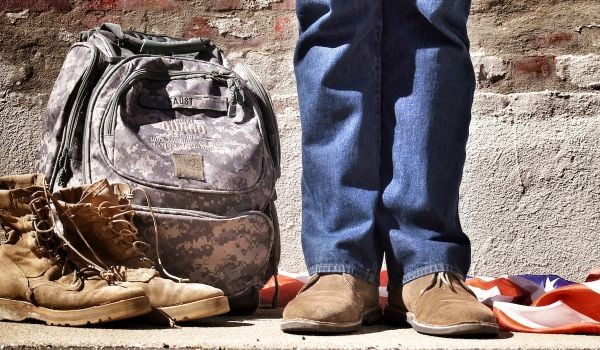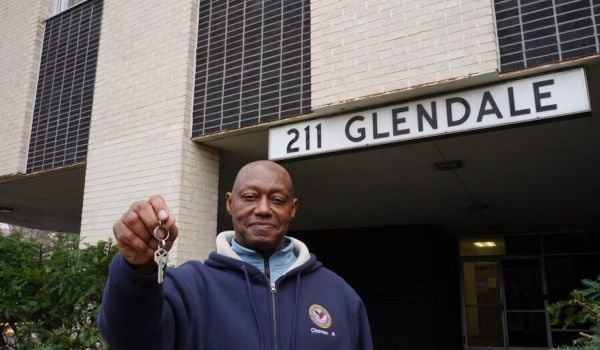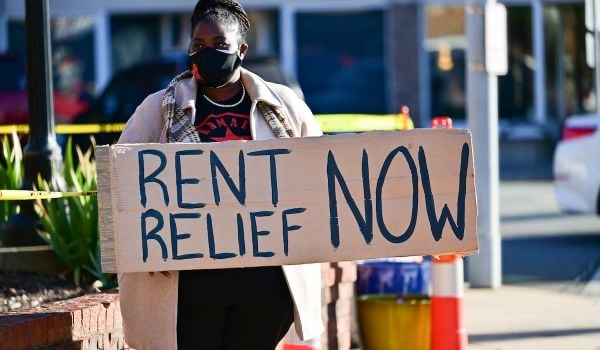In decades past, Rockford, Illinois, was a manufacturing hotbed. Sitting 90 miles northwest of Chicago, Rockford was the second largest furniture manufacturer in the U.S. during the first half of the 20th century. But, like many other places across the Rust Belt, as World Wars I and II came and went, so did the manufacturing industry that Rockford relied on. The recessions of the ‘70s and ‘80s were particularly damaging for the region, with manufacturing jobs declining by 34% between 1950 and 1980.
As unemployment rates rose, so did homelessness. In 2014, roughly 700 of the city’s 147,000 residents were unhoused.
Rockford has been working to reverse that trend since partnering with Community Solutions, a New York City nonprofit dedicated to ending homelessness through a housing-first approach, in 2015. As a result, in 2017 Rockford became the first city in the nation to reach functional zero, effectively ending homelessness, for two of the city’s homeless populations: veterans and the chronically homeless.
Reaching functional zero homelessness doesn’t mean that no one in Rockford experiences homelessness. But it does mean that there are more people getting housed than there are people becoming homeless. And that when homelessness does occur, it’s rare and brief.
The journey towards functional zero began in 2015 when Angie Walker, the city’s housing advocate under its community services division, came across Community Solutions’ Built for Zero initiative on the internet. Walker was intrigued by what has grown from movement of 70 communities to over 100, working to end homelessness in a way that’s both measurable and equitable. She brought the idea to her boss in 2015, got the green light, and began by streamlining the city’s homelessness services and tracking everyone in the community experiencing homelessness.
By 2015, the U.S. Department of Housing and Urban Development had mandated that communities receiving federal funding must develop a coordinated entry system, a process that aims to identify those in a housing crisis and assess, refer and connect them to housing assistance based on their needs. That’s a core part of the Built for Zero approach.
Rockford was already working toward developing such a coordinated entry system when it began partnering with Community Solutions. Together they decided that Rockford would implement a single point of entry, which was Walker’s agency. “It could be our physical location, phone calls,” Walker says. The goal of the process was to ensure that her agency would be notified whenever someone became homeless.
Community Solutions helped Walker and company begin conducting outreach by going out into the community to try to get people into the system proactively rather than reactively. Every person experiencing homelessness that they come into contact with goes through an intake process that involves adding their name to a list that her agency keeps.
Everyone on the list is sorted into five populations — single adults, youth under 25, veterans, chronically homeless and families with children. In Rockford today, the by-name list documents six veterans, one chronically homeless person, 22 families with children, nine youth and 147 single adults experiencing homelessness..
From there, Walker’s agency works with partner agencies, from the city department that’s charged with handling encampments (code enforcement) to hospitals and mental health service providers on temporary housing solutions, like shelters – while working on securing more permanent housing solutions based on each population’s and each individual’s needs. For low-income individuals, Walker’s team works to connect them to the city’s low-income housing; for veterans, they work with the Department of Veterans Affairs.
In 2010, Michelle Obama launched a push for ending veteran homelessness, so the 74 veterans on the original by-name list were the natural place for Walker to focus the city’s efforts. By partnering with veterans’ agencies and simply “going to town on housing” by connecting unhoused individuals with existing options as Walker put it, by the end of 2015 Rockford had reached functional zero for veterans.
The next population they set their sights on was the chronically homeless, for whom the city reached functional zero in 2017, making them one of only a handful of cities — along with Bakersfield, California, Abilene, Texas, and Medicine Hat in Alberta, Canada — to have achieved this.
Ramina Davidson, who serves as Community Solutions’ Built for Zero system-wide strategy lead, is quick to give credit to Rockford. “We do a lot of facilitation and a lot of convening, but it’s really the community’s work,” she says. “We provide data and tools. When a tool doesn’t exist, we co-create it with them.”
The by-name list has been a critical tool in Rockford’s arsenal. As Davidson explains, real-time, comprehensive data is key to countering homelessness.
“They have to know everybody in their community who’s experiencing homelessness. You have to actually count them,” she says.
It’s from this list that the city tracks demographics to ensure that there aren’t disparate outcomes for communities of color. Armed with data, communities can begin to understand what their homeless population looks like, what their needs are and where they can begin to make targeted investments.
In Rockford, that meant taking a deep look at mental health. Walker and company soon realized that mental health needs were falling through the cracks; that most people only got the services they needed in hospital settings or encounters with law enforcement or the criminal justice system.
Early this year, Rockford created a committee of partner agencies from the police department and code enforcement to mental health providers and hospitals to begin to unravel the problem. The group began mapping the holes in services. They’re currently learning how mental health services work within the city’s jail system.
Rockford’s endeavors haven’t been entirely smooth sailing. After reaching functional zero for veteran and chronically homeless populations, they shifted to focus on youth homelessness, but it was a tricky shift.
“We worked with youth for about a year or so and just never made any progress,” Walker says. “They’ve always been a hard population… They come to get help, you get them on the list, you start working with them, and then their best friend’s mom says they can stay with them. Then you never hear from them until six months later when they just pop up again.”
Instead, Rockford has shifted its next immediate focus on families with kids. “They tend to be a little easier to get housed,” she says. “Oftentimes moms with children are really, really motivated to get out of the shelters or wherever and get a place with their kids.”
Getting alignment across all of their various partner agencies has been a challenge, too, Walker says. This is largely because each entity, from the police to the hospitals, has a different goal. But years of consistent partnership across changes in leadership has led to an increase in understanding.
Right now, Rockford is on a path towards functional zero for all populations sometime next year. It’s a difficult goal, but one that Walker is determined to meet.
“It’s hard right now,” Walker concedes. “With staffing and funding issues with just the way the world is — evictions are out of control, rent prices are out of control — there’s so many variables that we’re trying to work within. But it’s attainable. I believe that we can do it. It might take a little bit more work than we thought initially, but I think we can do it.”
This story has been updated to correct the number of communities participating in the Built for Zero initiative as well as Davidson’s job title. We regret the errors.
This article is part of Backyard, a newsletter exploring scalable solutions to make housing fairer, more affordable and more environmentally sustainable. Subscribe to our weekly Backyard newsletter.

Cinnamon Janzer is a freelance journalist based in Minneapolis. Her work has appeared in National Geographic, U.S. News & World Report, Rewire.news, and more. She holds an MA in Social Design, with a specialization in intervention design, from the Maryland Institute College of Art and a BA in Cultural Anthropology and Fine Art from the University of Minnesota, Twin Cities.
Follow Cinnamon .(JavaScript must be enabled to view this email address)


















